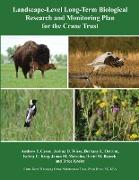- Start
- Landscape-Level Long-Term Biological Research and Monitoring Plan for the Crane Trust
Landscape-Level Long-Term Biological Research and Monitoring Plan for the Crane Trust
Angebote / Angebote:
Implementing a long-term monitoring program will help us more critically assess the impacts of our management actions to better understand their impacts upon Whooping Cranes, Sandhill Cranes, and the other bird species that pass through and breed in the Big Bend region of the Platte River in Nebraska. It is also our responsibility to publish, in scientific journals and management publications, the results of our research so that we may inform our colleagues in the conservation community and maintain a public record of our research program at the Crane Trust. We need to better understand dynamic ecological change in the long view by implementing an achievable, straight-forward research and monitoring strategy on the Crane Trust's properties. We have an opportunity to collect ecological information on an important mosaic of wet meadows, river channels, sloughs, woodlands, and tallgrass prairies, across a diversity of soil types and biotic communities, under a variety of management regimes. So much incredible research has been done at the Platte River Whooping Crane Maintenance Trust over the last 40 years. One way in which we can continue this legacy is via the continued implementation of our long-term research and monitoring efforts, allowing us to be cooperators in the great task of understanding the "long-scale" ecological changes taking place in the Great Plains, and in our world. This is the future trend of ecological science and land management, we are moving from shorter-term experiments to long-term data collection as a standard practice for understanding the ecological systems we inhabit.
-Platte River Whooping Crane Maintenance Trust, Wood River, NE, USA
Folgt in ca. 10 Arbeitstagen




